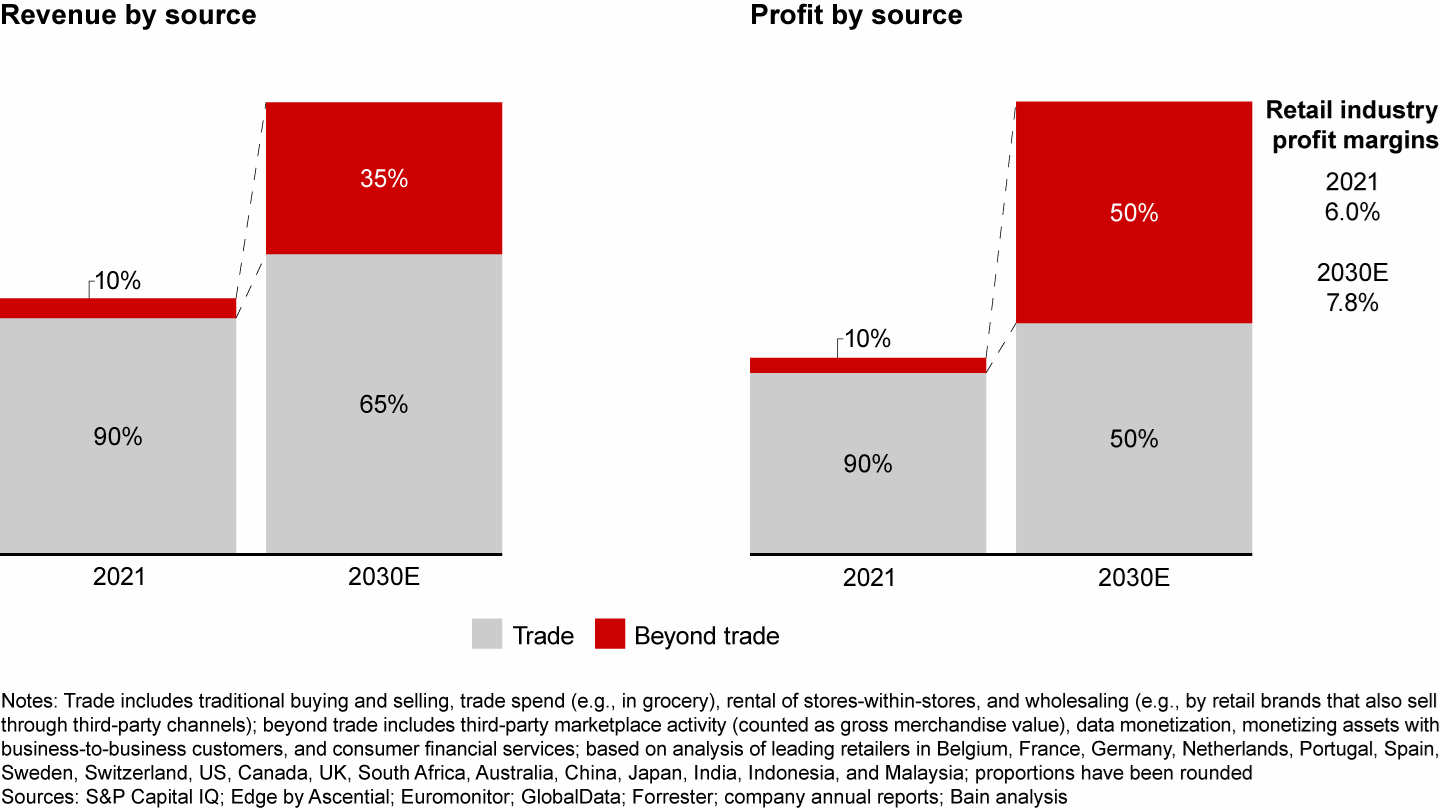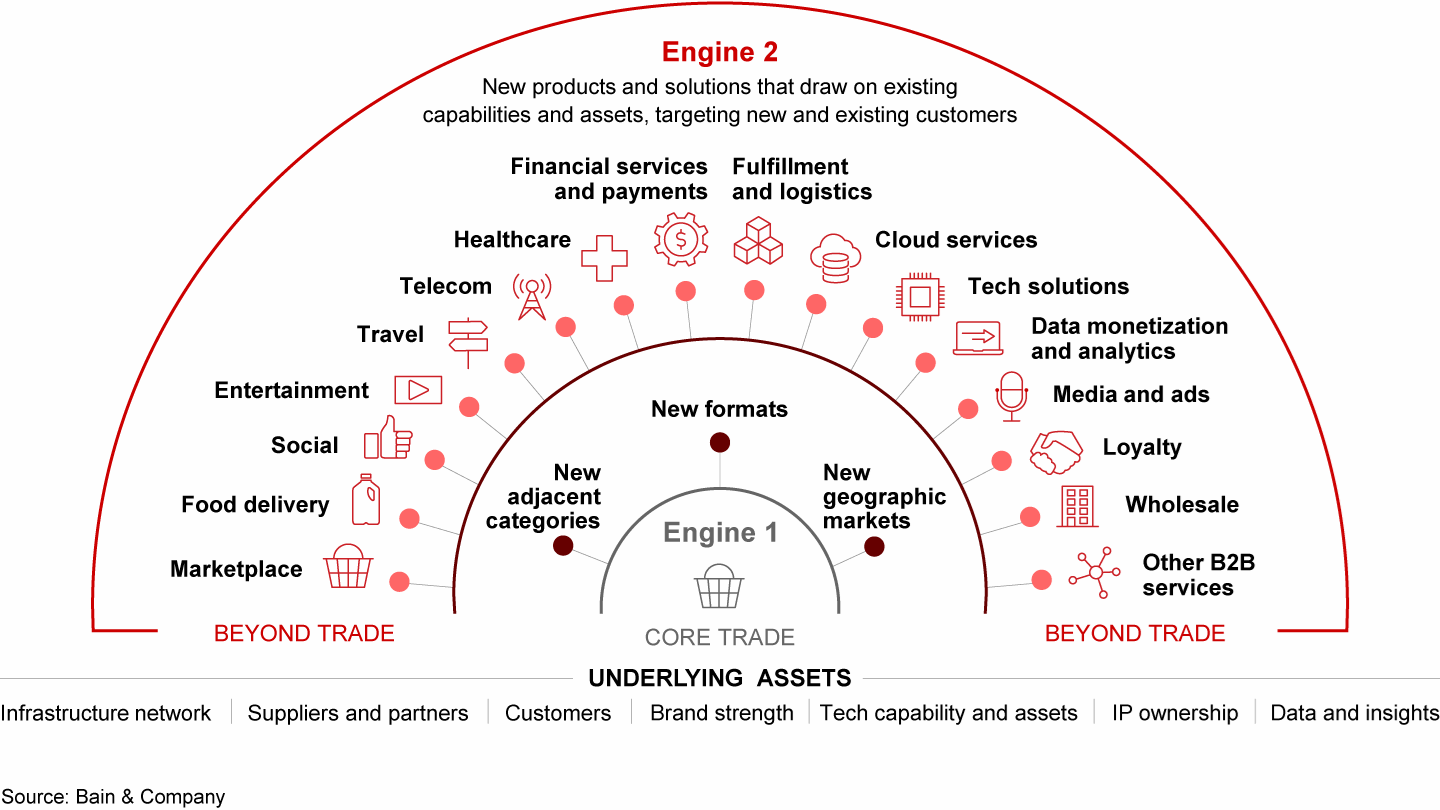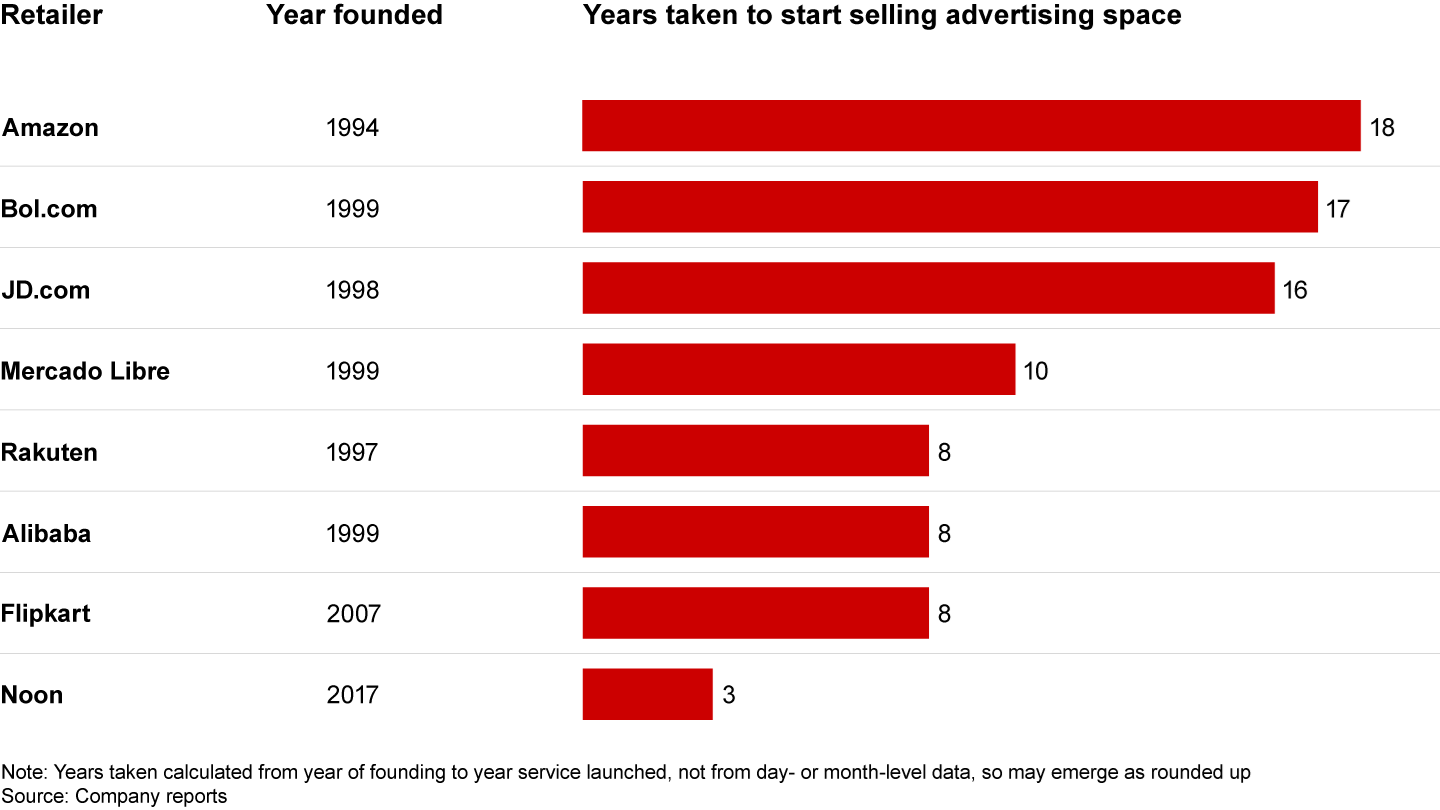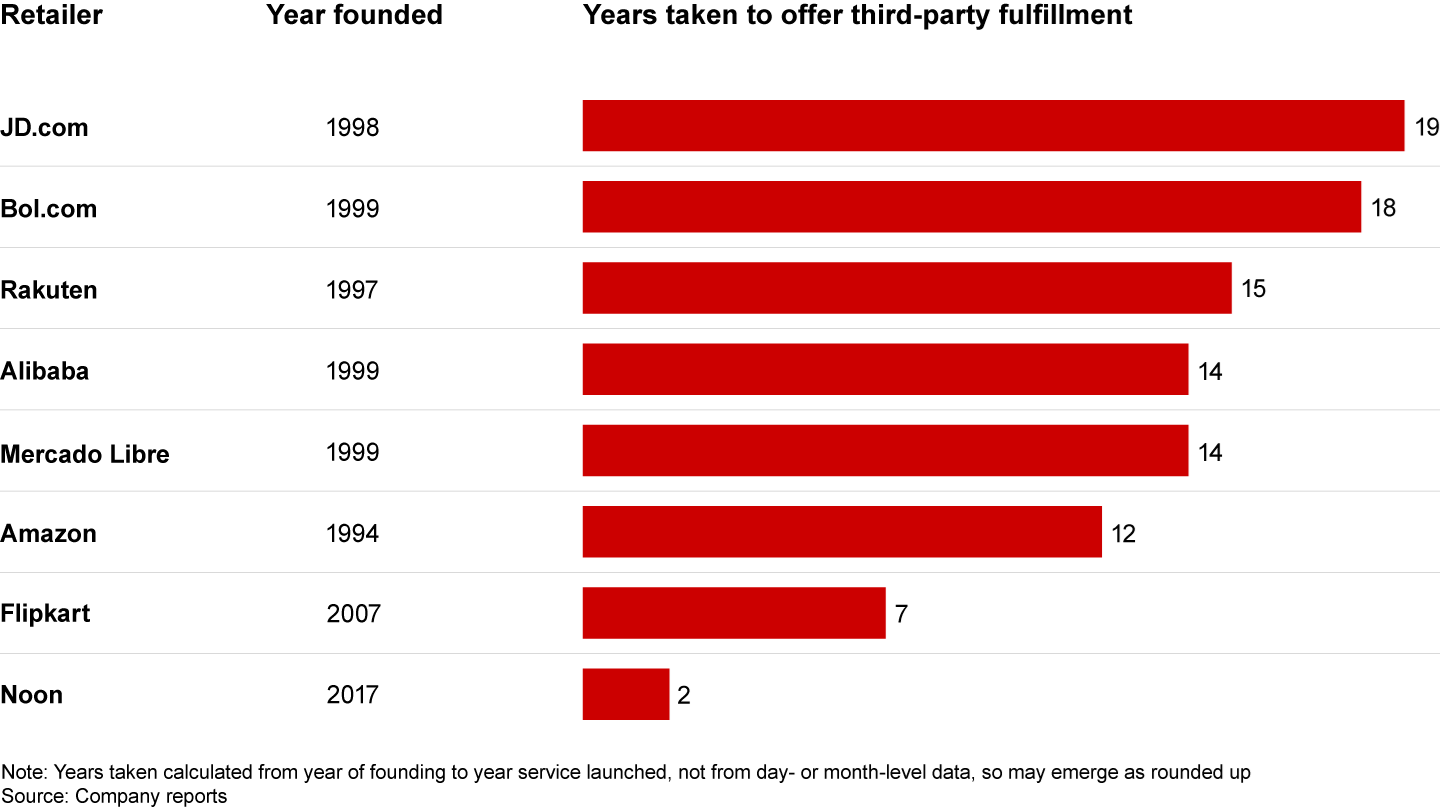Brief

Auf einen Blick
- Growth is becoming more elusive in core retailing activities, to the extent that, by 2030, half of industry profits could come from nontraditional sources such as marketplaces, advertising, and financial services.
- Retailers can seize the opportunities that lie “beyond trade” by launching Engine 2 businesses that unlock the potential of strategic assets they already own (or capabilities they already have).
- As Engine 2 development accelerates, three imperatives are vital for successful expansion outside the core: Choose strategic battles carefully, craft a compelling investment story, and anticipate operating model tensions.
Retailers old and new have been increasingly branching out through the creation of “Engine 2” businesses. Omnichannel players with a long history of physical retailing are moving into areas such as advertising, data services, third-party fulfillment, and financial or health services. These Engine 2 ventures can create a step change in revenue growth and compensate for the diminishing opportunity available through their traditional growth levers (such as expansion of store footprint).
For digital-native retailers focused mainly or exclusively on e-commerce, Engine 2 expansion can be a tonic for profitability. Many such players don’t yet have the earnings to match their impressive scale; attractive Engine 2 profit opportunities can offset their weak e-commerce margins.
As a potent solution for both revenue and profit growth, Engine 2 business creation is only likely to become a bigger strategic priority for retail. While forecasting amid today’s volatility is tricky, Bain & Company estimates that, between 2021 and 2030, retailers in key markets will see only modest growth in sales and profit from core retailing (meaning activities centered on the sale of goods procured from suppliers). Contrast that with the rosy outlook for activity that reaches beyond trade, including marketplaces, data monetization, and advertising. Strong growth could mean “beyond trade” activity accounts for about 50% of retailer profit in 2030, up from 10% in 2021 (see Figure 1).
Half of retailer profits could come from “beyond trade” diversification by 2030, according to our analysis in 18 key markets


With growth likely to become more elusive in core retailing, Engine 2 business creation could determine the sector’s winners and losers. But while the stakes are high, retailers should be fired up about the opportunity. The sector need only look at Amazon to see how moving beyond the retail core can be transformational. In 2022, its advertising business generated $37.7 billion in net sales after stellar growth (including a 19% year-over-year increase in the fourth quarter). Overall, more than half of Amazon’s 2022 net sales came from outside its online and physical-store reporting segments.
There’s still time (and room) for executive teams to use Engine 2 expansion to power their own businesses beyond trade—if they make the right moves today.
Unlocking the potential of existing strategic assets
Many scale retailers, both omnichannel leaders and e-commerce pure plays, are well placed to create Engine 2 businesses by unlocking the growth potential of strategic assets they already own (or capabilities they already have).
These assets and capabilities include vast databases that offer valuable proprietary insights into consumer behavior; extensive logistics networks that third parties could piggyback upon; existing customer traffic to physical stores, websites, and apps that could be monetized in new ways; cloud and payments technology used for today’s core retailing that could be repurposed for other partners; deep supplier relationships that provide a ready-made audience for new advertising ventures; and a strong brand that can underpin expansion into financial services, health, and other areas where trust is essential.
Consider JD.com’s expansion into the supply of affordable virtual healthcare consultations with family doctors, via its JD Health International arm. The service is one of a growing number of healthcare Engine 2s developed by retailers around the world, including Kroger in the US, Canada’s Loblaw, and Switzerland’s Migros. Reaching people in areas of China that are not well served by physical healthcare facilities, JD Health International draws on a range of existing JD.com strengths: its brand, its digital expertise, its large customer base (588 million active accounts), and the willingness of its customers to act as advocates for its business. Tight integration with its online pharmacy business creates another advantage, in the form of one-stop shopping, for instance.
Beyond healthcare, there are multiple domains that offer retailers continued potential for profitable Engine 2 expansion—with options available in both the business-to-consumer (B2C) and business-to-business (B2B) spheres (see Figure 2). Collectively, they constitute an invigorating addition to Engine 1 growth moves focused on the expansion of core retailing in new formats, new geographic markets, or adjacent categories.
Profitable Engine 2 expansion is possible across many domains, supported by a range of underlying assets


Walmart is one of the scale retailers using existing assets in powerful retail media ventures. The approximately 230 million people globally who visit its stores and websites each week constitute a potent asset, albeit one that can’t be put on the balance sheet. That traffic has underpinned its flourishing global retail advertising arm, which by early 2023 had grown into a $2.7 billion-a-year business. Likewise, Carrefour’s retail media operation has expanded by offering access to about 80 million customers around the world and drawing on data for 8 billion transactions. Other retailers are capitalizing on similar assets in retail media—or could yet do so.
Bain research suggests that retail’s push into advertising builds on genuine competitive strengths: 59% of advertisers say that retail media networks offer benefits that other channels can’t replicate, while 60% believe tighter data privacy rules will make retail media more important (see the Bain infographic “How Retail Media Networks Can Win with Advertisers”). The attraction for advertisers includes targeted access to consumers close to the point of purchase. Advertisers also value the vast stores of first-party data that retailers can use to improve ad targeting.
Financial services continue to present opportunities well beyond the traditional banking that some retailers have offered for decades. Take digital wallets, for instance. By enabling cashless payment, they don’t just simplify checkout; they can also increase access to e-commerce, particularly in regions where many lack bank accounts or credit cards. Digital wallets generate payments data that can explain consumer purchase patterns and personalize marketing promotions. Benefits such as these have enabled retailers to undercut credit card issuers on fees charged to merchants. Balances held in digital wallets have also allowed players such as Alibaba to add new financial services profit streams, via expansion into broader lending and wealth management.
Not every Engine 2 will spark, however
While they have huge potential, Engine 2 businesses are not easy to build at the best of times, let alone amid rising capital costs, talent shortages, and relentless pressure to invest more in supply chains, pricing, and other core business priorities. Recent history is littered with Engine 2s that didn’t spark. Even Amazon, so successful at expanding beyond trade, has had the odd setback. For instance, its meal delivery service in the US was shut down in 2019, after failing to compete with more established players such as Grubhub, which it ended up partnering with instead.
The pace of Engine 2 development has accelerated, too, with retailers looking beyond trade much earlier. Amazon took 18 years from its founding in 1994 to branch out into retail network advertising; it took Noon, the Middle East e-commerce marketplace, 3 years from its own inception in 2017 to make the same move. Similarly, JD.com had been in business for 19 years when it started offering fulfillment services; it took India’s Flipkart only 7 years, while Noon had that capability in 2 years (see Figure 3).
Digital natives are branching out from core retailing at a much earlier stage of their development


Digital natives are branching out from core retailing at a much earlier stage of their development


After a period in which e-commerce pure plays made the greatest strides, long-established omnichannel retailers have also been moving quicker on the Engine 2 front in recent years, launching a flurry of new ventures and committing themselves to bold growth goals for their noncore retail activities. Walmart, for instance, has made a succession of Engine 2 moves in the past five years, including expansion into health centers, third-party fulfillment services, and data analytics.
These omnichannel scale players are also committing themselves to bold goals for their continuing push beyond their established activities. For instance, Carrefour is aiming to triple its e-commerce gross merchandise value to €10 billion between 2021 and 2026, including expansion in marketplaces and quick commerce. In the same period, it is also looking to add €200 million of recurring operating income from its digital strategy for financial services, among other diversification goals.
Three imperatives for Engine 2 success
Against this backdrop of macroeconomic challenges and accelerating new business creation, a few imperatives stand out as particularly important for Engine 2 expansion. Retailers should choose strategic battles carefully, craft a compelling investment story, and anticipate operating model tensions.
Choosing strategic battles carefully. The right Engine 2 strategy requires a clear understanding of the goal and how to measure success. Is the new business reinforcing an existing proposition? If so, measure success on incremental customer lifetime value. Or is it seeking new profit streams, perhaps from a different customer segment (such as B2B)? If so, measure success on contribution to overall profit. Such distinctions matter, as some Engine 2s are written off after mistakenly being judged on standalone profit contribution, not the customer lifetime value boost to the core business (which some companies struggle to track anyway).
It’s worth noting a third Engine 2 aim: indirect access to a bigger profit pool. For instance, the scale provided by a marketplace can make advertising or third-party “fulfilled by” models viable, even if the marketplace’s standalone economics don’t stack up.
Once clarified, the strategic goal must be rigorously tested for workability. Is the addressable market well defined and the profit pool large or growing? Will the new business meet an underserved need, or better meet an existing need with a new and disruptive solution? Realistically, how much time and investment will be needed to break even in various scenarios, and is that acceptable? Do you have the scale, assets, expertise, and partnerships to be credible as a new entrant?
Remember that building a conglomerate of independent business units is not the goal. Engine 2 expansion works best when it ties in closely with the core—for instance, by increasing the “stickiness” of a retail ecosystem through capturing more of the customer’s attention and spending.
Crafting a compelling investment story. A new growth engine can boost a retailer’s stock price in the expectation of future profits, especially in the early days, before it breaks even. Yet Engine 2 projects requiring heavy, multiyear investment can test the patience of investors, especially those used to strong cash flow and dividend payouts. Some might prefer to invest directly in start-ups rather than fund a retailer’s disruptive growth ambitions. Sentiment has also turned against early-stage investments with an uncertain path to profit, amid a broad revaluation of tech stocks. While digital-native retailers were granted years to build up their initially loss-making ecosystems, even they are now under pressure to increase short-term profit.
All of these factors underline the need for executive teams to craft a compelling equity story for Engine 2 ventures. That narrative must be simple, tangible, authentic, measurable, and exciting. A robust, rather than rose-colored, view of cash flow is vital. Forecasting is more fraught than usual today, and retailers need to understand profit outcomes and consequences in different scaling scenarios. But current and future investors still want to see a clear path to profitability.
Lastly, retailers should invest in their Engine 2 projects like a venture capital outfit, releasing funds in phases as the business gains traction and confidence grows in its ability to scale. That can lower the risk of capital and operating expenditure commitments, while building credibility with investors.
Anticipating operating model tensions. Building a new growth engine is different from day-to-day operations. It requires a shift from tight control to delegated trust—and a “pivot, persevere, or perish” mindset based on prototyping and short feedback loops. This likely means grounding the operating model in agile principles. In such a model, leaders set the new business growth mission, then empower the innovation team to execute on it. They adopt a venture capital–style flexibility in planning and prioritization, resource allocation, and performance review. They hire new talent and create new roles, to inject expertise and innovation experience. They also strengthen business processes and technology that might otherwise slow progress.
Often, setting up a separate unit with the license to operate differently is the quickest way to achieve agility. But that unit will still need access to core business assets, which can cause friction in areas such as objective setting, transfer pricing, and sales and profit recognition. For example, the team setting up a retail media business might clash with the retailer’s buyers. The former might see suppliers solely as potential customers, but buyers have a more complex relationship with suppliers, including sometimes-tense pricing negotiations. The new business might also cannibalize the core. And, as it scales, there’s also the question of whether (and how) it should be reintegrated.
In all of these contexts, retailers need to anticipate the necessary operating model changes. From the new venture’s creation, they must be clear on structure, accountabilities, transfer pricing, and the recognition of sales and profit.
Converging on a sustainable economic formula
The mounting importance of Engine 2 expansion is a powerful demonstration of the convergence that will be one of the defining characteristics of retail over the next decade (see the Bain Brief “The Future of Retail: The Age of Convergence”). Companies with a long history in physical retail need Engine 2 growth. So do digital natives that have only been operating a decade or two, or even just a few years. In both cases, it’s about making the economics of retail sustainable for the long term, at a time when the deepening penetration of the online channel is putting sustained dilutive pressure on profits.
Moving outside the core and into the unfamiliar requires a careful approach, but retailers should not underestimate the Engine 2 potential of existing assets: They can be the platform for a truly profitable future.